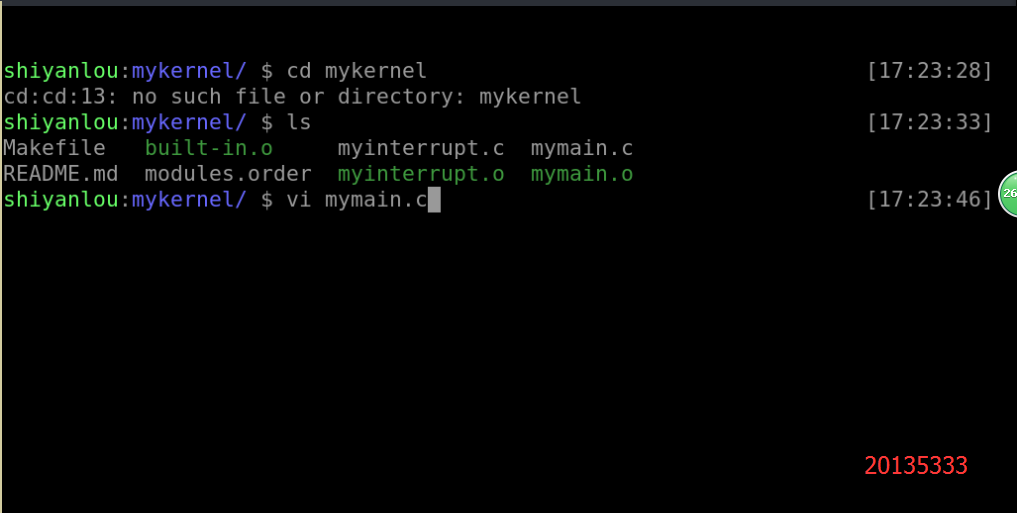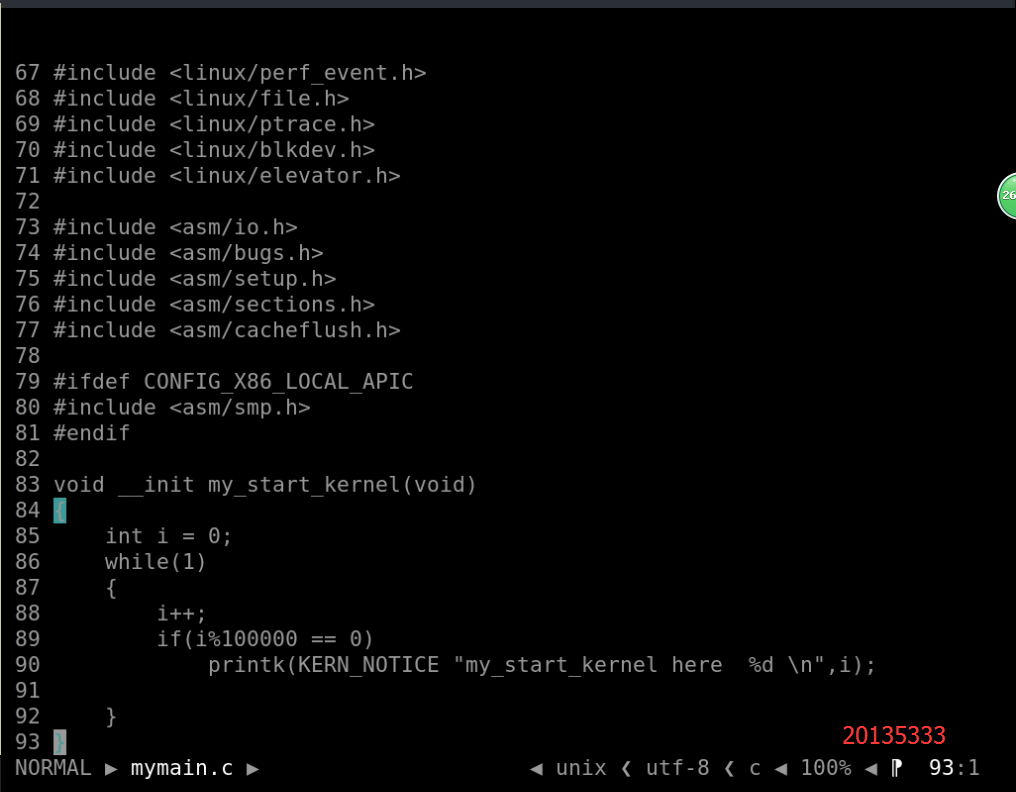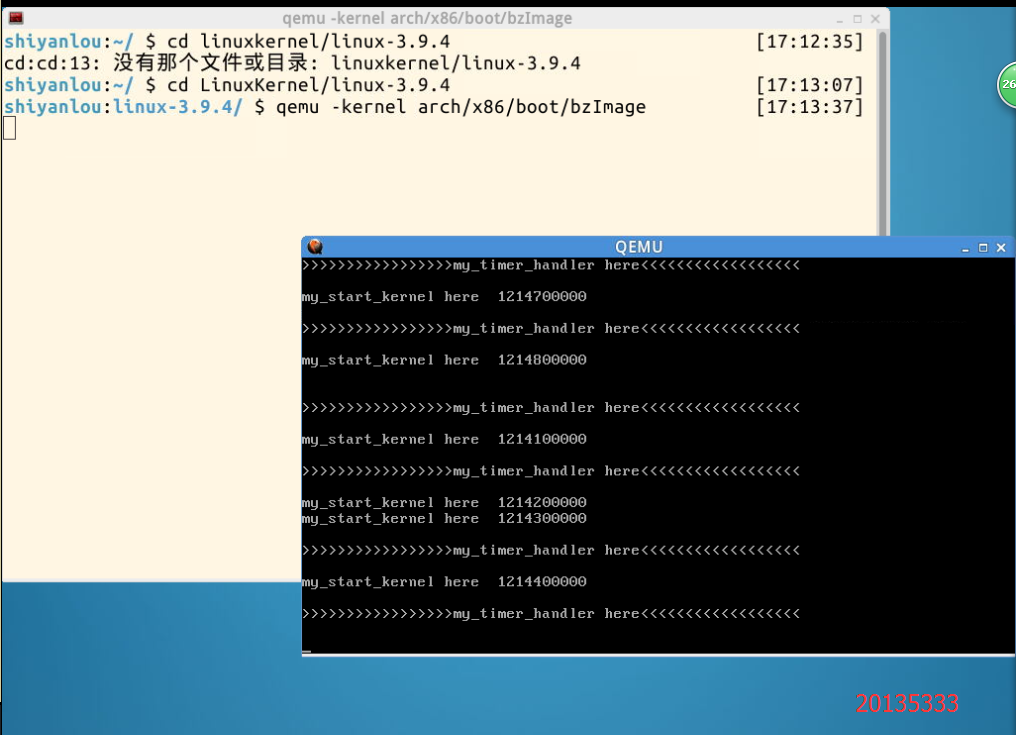Linux内核设计(第二周)——操作系统工作原理
一、学习笔记总结
1.函数调用堆栈
(1)、函数调用堆栈。
堆栈是C语言程序运行时必须的一个记录调用路径和参数的空间。
cpu内部已经集成好的功能,pop,push,enter……
函数调用构架
传递参数,通过堆栈
保存返回值,%eax
提供局部变量空间
……
C语言编译器对堆栈的使用有一套自己的规则,功能相同,指令有区别。
(2)、深入理解函数调用堆栈
-
堆栈相关的寄存器:
%esp——堆栈指针
%ebp——基址指针 -
堆栈操作
push——栈顶地址减少
pop——相反 -
%ebp在C语言中用作记录当前函数调用基址
-
其他关键寄存器
CS:eip:总是指向下一条的指令地址
顺序执行、跳转|分支(cs:eip的值会根据程序的需求更改)、call、ret、发生中断时。 -
调用函数
call指令:
(1) 将eip中下一条指令的地址A保存在栈顶;
(2) 设置eip指向被调用程序代码开始处。
ret(return)指令:将地址A恢复到eip中
(3)、传递参数与局部变量
方法:gcc-g生成可执行文件,用objdump -S获得反汇编文件。
2.利用Linux内核部分源代码分析存储程序计算机工作模型及时钟中断
(1).mykernel实验平台涉及的思想
三大法宝:
存储程序计算机
函数调用堆栈
中断
当中断发生时,由CPU和内核代码共同实现了保存现场和恢复现场。
把eip指向中断处理程序的入口,保存现场。
二.利用mykernel实验模拟计算机硬件平台
1.实验过程
使用实验楼的虚拟机打开shell
cd LinuxKernel/linux-3.9.4
qemu -kernel arch/x86/boot/bzImage
然后cd mykernel 您可以看到qemu窗口输出的内容的代码mymain.c和myinterrupt.c

mymain.c文件关键代码部分

myinterrupt.c文件关键代码部分

2.代码分析
(1)mymain.c
/*
* linux/mykernel/mymain.c
*
* Kernel internal my_start_kernel
*
* Copyright (C) 2013 Mengning
*
*/
#include <linux/types.h>
#include <linux/string.h>
#include <linux/ctype.h>
#include <linux/tty.h>
#include <linux/vmalloc.h>
#include "mypcb.h"
tPCB task[MAX_TASK_NUM]; //声明一个PCB数组
tPCB * my_current_task = NULL; //声明当前task指针
volatile int my_need_sched = 0; //是否需要调度标志
void my_process(void);
void __init my_start_kernel(void)
{
int pid = 0;
int i;
/* 初始化 0号进程*/
task[pid].pid = pid;
task[pid].state = 0;/* -1 unrunnable, 0 runnable, >0 stopped */
task[pid].task_entry = task[pid].thread.ip = (unsigned long)my_process; /* 实际上是my_process*/
task[pid].thread.sp = (unsigned long)&task[pid].stack[KERNEL_STACK_SIZE-1];
task[pid].next = &task[pid]; // 定义堆栈的栈顶
/*创建更多的子进程*/
for(i=1;i<MAX_TASK_NUM;i++)
{
memcpy(&task[i],&task[0],sizeof(tPCB));
task[i].pid = i;
task[i].state = -1;
task[i].thread.sp = (unsigned long)&task[i].stack[KERNEL_STACK_SIZE-1];
task[i].next = task[i-1].next;
task[i-1].next = &task[i];
}
/* 从0号进程开始启动 */
pid = 0;
my_current_task = &task[pid];
asm volatile(
"movl %1,%%esp
" /* 设置 esp 的值*/
"pushl %1
" /* 将 ebp 压栈(此时esp=ebp),%1相当于task[pid].thread.sp*/
"pushl %0
" /* 将 eip 压栈,%0相当于task[pid].thread.ip*/
"ret
" /* 相当于 eip 出栈 */
"popl %%ebp
" /* 0号进程正是启动 */
:
: "c" (task[pid].thread.ip),"d" (task[pid].thread.sp) /* input c or d mean %ecx/%edx*/
);
}
void my_process(void)
{
int i = 0;
while(1)
{
i++;
if(i%10000000 == 0)
{
printk(KERN_NOTICE "this is process %d -
",my_current_task->pid);
if(my_need_sched == 1)
{
my_need_sched = 0;
my_schedule();
}
printk(KERN_NOTICE "this is process %d +
",my_current_task->pid);
}
}
}
(2)myinterrupt.c
/*
* linux/mykernel/myinterrupt.c
*
* Kernel internal my_timer_handler
*
* Copyright (C) 2013 Mengning
*
*/
#include <linux/types.h>
#include <linux/string.h>
#include <linux/ctype.h>
#include <linux/tty.h>
#include <linux/vmalloc.h>
#include "mypcb.h"
extern tPCB task[MAX_TASK_NUM];
extern tPCB * my_current_task;
extern volatile int my_need_sched;
volatile int time_count = 0;
/*
* Called by timer interrupt.
* it runs in the name of current running process,
* so it use kernel stack of current running process
*/
void my_timer_handler(void)
{
#if 1
if(time_count%1000 == 0 && my_need_sched != 1)
{
printk(KERN_NOTICE ">>>my_timer_handler here<<<
");
my_need_sched = 1;
}
time_count ++ ;
#endif
return;
}
void my_schedule(void)
{
tPCB * next;
tPCB * prev;
if(my_current_task == NULL
|| my_current_task->next == NULL)
{
return;
}
printk(KERN_NOTICE ">>>my_schedule<<<
");
/* schedule */
next = my_current_task->next;
prev = my_current_task;
if(next->state == 0)/* -1 unrunnable, 0 runnable, >0 stopped */
{
/* 进程切换跳转到下一进程 */
asm volatile(
"pushl %%ebp
" /* 保存当前ebp */
"movl %%esp,%0
" /* 保存当前esp */
"movl %2,%%esp
" /* 重新记录要跳转进程的 esp,%2为 next->thread.sp*/
"movl $1f,%1
" /* 保存当前 eip ,%1为prev->thread.ip*/
"pushl %3
"
"ret
" /* 记录要跳转进程的 eip,%3为 next->thread.ip*/
"1: " /* 下一个进程开始执行 */
"popl %%ebp
"
: "=m" (prev->thread.sp),"=m" (prev->thread.ip)
: "m" (next->thread.sp),"m" (next->thread.ip)
);
my_current_task = next;
printk(KERN_NOTICE ">>>switch %d to %d<<<
",prev->pid,next->pid);
}
else
{
next->state = 0;
my_current_task = next;
printk(KERN_NOTICE ">>>switch %d to %d<<<
",prev->pid,next->pid);
/* switch to new process */
asm volatile(
"pushl %%ebp
" /* 保存当前 ebp */
"movl %%esp,%0
" /* 保存当前 esp */
"movl %2,%%esp
" /* 重新记录要跳转进程的 esp ,%2为 next->thread.sp*/
"movl %2,%%ebp
" /* 重新记录要跳转进程的 ebp,%2为 next->thread.sp */
"movl $1f,%1
" /* 保存当前 eip ,%1为prev->thread.ip,%1f就是指标号1:的代码在内存中存储的地址*/
"pushl %3
"
"ret
" /* 重新记录要跳转进程的 eip,%3为 next->thread.ip */
: "=m" (prev->thread.sp),"=m" (prev->thread.ip)
: "m" (next->thread.sp),"m" (next->thread.ip)
);
}
return;
}
#三、总结
本周从计算机操作系统对于程序的调用学起,结合了以前学习的汇编、C语言的知识,对于计算机内部对于中断的处理和进程切换有新的认识。有一些不明白的内容老师也在课堂上已经做出了详细的解答,很形象生动。本周因为一些个人因素进度有些太慢,这种情况应该有所规避,以后要改正。
